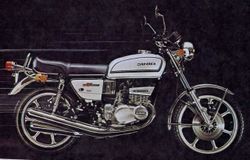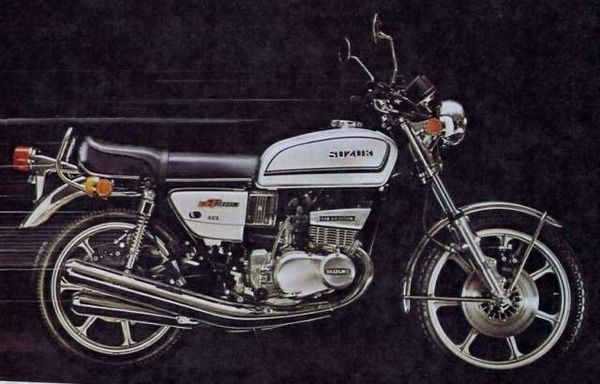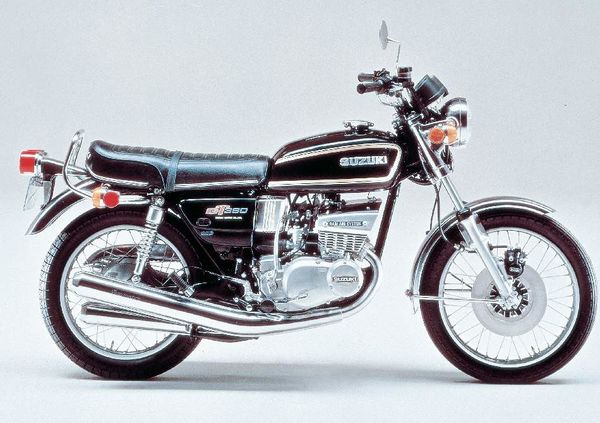Difference between revisions of "Suzuki GT380C"
(upgrading template) |
(adding recommended_oil) |
||
| Line 37: | Line 37: | ||
|fuel_capacity = 15 Liters / 4.0 US gal / 3.3 Imp gal | |fuel_capacity = 15 Liters / 4.0 US gal / 3.3 Imp gal | ||
|oil_capacity = 1.3 Liters / 2.7 US pt / 2.2 Imp pt | |oil_capacity = 1.3 Liters / 2.7 US pt / 2.2 Imp pt | ||
|recommended_oil=Suzuki ECSTAR 10w40 | |||
|fuel_consumption = | |fuel_consumption = | ||
|turning_radius = | |turning_radius = | ||
Revision as of 02:00, 10 November 2019
 |
|
| Suzuki GT380C | |
| Manufacturer | |
|---|---|
| Production | 1978 |
| Engine | Two stroke, transverse three cylinder |
| Compression ratio | 7.2:1 |
| Top Speed | 153 km/h / 95 mph |
| Ignition | Battery and coil |
| Transmission | 6 Speed |
| Suspension | Front: Telescopic fork, oil dampened Rear: Dual shocks, springs, 5-way adjustable |
| Brakes | Front: Single 275 mm disc Rear: 180mm drum |
| Front Tire | 3.00-19 4PR |
| Rear Tire | 3.50-18 4PR |
| Wheelbase | 1379 mm / 54.3 in |
| Seat Height | 787 mm / 31 in |
| Weight | 171 kg / 377 lbs (wet) |
| Oil Capacity | 1.3 Liters / 2.7 US pt / 2.2 Imp pt |
| Recommended Oil | Suzuki ECSTAR 10w40 |
| Fuel Capacity | 15 Liters / 4.0 US gal / 3.3 Imp gal |
| Manuals | Service Manual |
It could reach a top speed of 153 km/h / 95 mph.
Engine
The engine was a Air cooled cooled Two stroke, transverse three cylinder. The engine featured a 7.2:1 compression ratio.
Drive
Power was moderated via the Wet, multiplate.
Chassis
It came with a 3.00-19 4PR front tire and a 3.50-18 4PR rear tire. Stopping was achieved via Single 275 mm disc in the front and a 180mm drum in the rear. The front suspension was a Telescopic fork, oil dampened while the rear was equipped with a Dual shocks, springs, 5-way adjustable. The GT380C was fitted with a 15 Liters / 4.0 US gal / 3.3 Imp gal fuel tank. The wheelbase was 1379 mm / 54.3 in long.
Photos
Overview
Suzuki GT 380
Suzuki launched its air-cooled two-stroke triples GT380 and GT550 in 1972. An water-cooled three-cylinder GT750 had already been presented a year earlier and the 380 and 550 followed the design of the flagship model.
The GT380 and GT550 were predicatable and sporty motorcycles, but
up to a
point. At touring speeds they were comfortable and
smooth, but twisting the grip farther brought a wobble and cornering at higher speeds showed the limitations of the suspension, swinging arm and the tube frame.
The GT engines were less highly tuned than for example the Kawasaki triples. It was tuned for the long run. Porting, timing,
compression, carburetor size etc. were all chosen to deliver smooth power at the expence of maximum power. It made the Suzuki GTs more reliable than fast. The odd 3 to 4 exhaust system and rigid foot pegs also limited the leaning angle and the sporting nature of the bike. The GT triples were
simply made for touring and not for sport-styled
riding.
The Ram Air System (introduced in all of the air-cooled GT models) that
forced the cool air to pass through the
cylinders and behind the block was a new developement, tested earlier on Suzuki's TR500 racers. It is an simply an air scoop that ducts cold air directly onto the cylinder head the help the cooling on the engine. It was a known problem
that two-stroke engines lost power when the cylinder head temperature rose
too much. Cooling problem plagued
other two-stroke triples but the Ram Air System made the Suzuki GT triples less
suspective to the charasteric two-stroke power loss caused by too high a cylinder head temperature after
a long, hard run. Nevertheless
the GT triples still had a reputation for
the middle piston seizing.
Suzuki's automatic system mixing
fuel and oil had been refined for the GT models, providing
less exhaust smoke, now called CCI. A clever new item in the early seventies
was the vacuum-operated petcock was first used on the GTs and later used on all Suzuki mototrcycle models.
Both triples saw some minor improvements every year of their production but after only few of years production
the two-stroke engined street bikes were terribly out of fashion. Although
the GT380 was as strong and reliable as a four-stroke of
equal displacement the rather high fuel comsuption of the two-strokers was
suddenly an issue, when the gasoline prizes rose in the seventies.
Even Suzuki itself dug a grave to its two-stroke models by launching its highly popular GS series with four-stroke
angines. It was actually forced
to change their minds and start making four-stroke engines. The
tighter emission regulations in America sounded the death knell for most two-strokes.
Source suzukicycles.org
| Make Model | Suzuki GT 380C |
|---|---|
| Year | 1978 |
| Engine Type | Two stroke, transverse three cylinder |
| Displacement | 371 cc / 22.6 cu in |
| Bore X Stroke | 54 x 54 mm |
| Compression | 7.2:1 |
| Cooling System | Air cooled |
| Exhaust | 3 into 4, stainless steel |
| Induction | 3 x 24mm Mikuni carburetors |
| Ignition | Battery and coil |
| Starting | Kick |
| Max Power | 27.7 kW / 38 hp @ 7500 rpm |
| Max Torque | 38 Nm / 3.9 kgf-m / 28 lb-ft @ 6000 rpm |
| Clutch | Wet, multiplate |
| Transmission | 6 Speed |
| Final Drive | Chain |
| Front Suspension | Telescopic fork, oil dampened |
| Rear Suspension | Dual shocks, springs, 5-way adjustable |
| Front Brakes | Single 275 mm disc |
| Rear Brakes | 180mm drum |
| Front Tire | 3.00-19 4PR |
| Rear Tire | 3.50-18 4PR |
| Dimensions | Length: 2090 mm / 82.3 in Width: 815 mm / 32.1 in Height: 1125 mm / 44.3 in |
| Wheelbase | 1379 mm / 54.3 in |
| Ground Clearance | 145 mm / 5.7 in |
| Seat Height | 787 mm / 31 in |
| Wet Weight | 171 kg / 377 lbs |
| Fuel Capacity | 15 Liters / 4.0 US gal / 3.3 Imp gal |
| Oil Capacity | 1.3 Liters / 2.7 US pt / 2.2 Imp pt |
| Standing ¼ Mile | 13.8 sec |
| Top Speed | 153 km/h / 95 mph |

